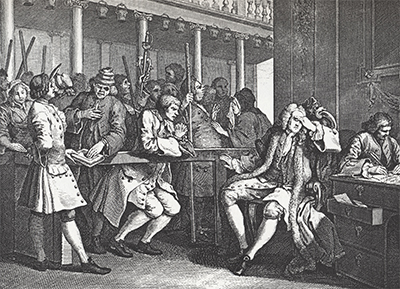The Industrious 'Prentice Alderman of London, the Idle one brought before him & Impeach'd by his Accomplice is an etching (with some engraving) created by the English artist, William Hogarth (1697-1764), on 30 September 1747.
It is Plate 10 from his "modern moral", allegorical and satirical series, 'Industry and Idleness'. Its dimensions are 26 x 35 cm. The twelve prints were later described by Hogarth himself as "calculated for the use of instruction of Youth" and emphatically warn against bad conduct and the disorder that shall ensue. They follow the very contrasting developments in the fortunes, careers, environments, physical appearances and expressions of the good and bad City apprentices, Francis Goodchild and Tom Idle, respectively. These protagonists are only seen together in Plate 1, and Plate 10 when they are finally reunited and Idle's general demeanour and circumstances have greatly deteriorated. Plate 11 culminates in the cart ride to the gallows at Tyburn for his ignominious execution.
In this composition, Goodchild has become a very respectable alderman and magistrate and Idle a common criminal. The exact situation in this scene is difficult to decipher and we must guess from Hogarth's clues. We are ignorant of the levels of culpability, for the robbery and murder committed, of Idle and his partner-in-crime, who has a hand on the Bible during an oath for the veracity of his testimony against the former. In addition, why is the judge turning away abruptly from the accused, who is begging for mercy and for his version of events to be heard and believed? Is it because Goodchild is revolted by or sympathises with his erstwhile associate?
The Leviticus quotation below Goodchild is crucial: "Thou shalt do no unrighteousness in Judgement", which implies that the judge has no choice but to condemn the guilty Idle. The alderman may well be impartial and an independent adjudicator but is the accused actually guilty? Is the accomplice really telling the truth and why should he be trusted? Indeed, the integrity of the whole judicial system is compromised and impugned when the court official is seen holding the Bible with one hand and furtively accepting a bribe with the other! Hogarth was an avid social commentator and critic, and very perceptive in his brutally realistic, hard-edged observations of the best and worst elements of the human condition.




